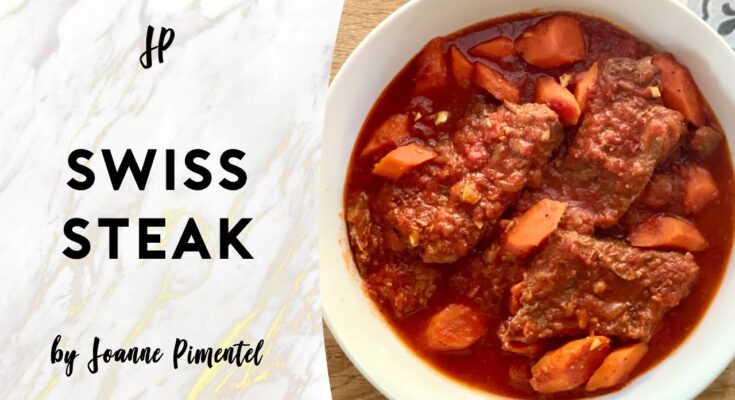Swiss Steak Recipe: Swiss steak is a comforting and hearty dish that brings together tender beef, a rich tomato-based sauce, and perfectly cooked vegetables. It’s the kind of meal that feels like a warm hug on a cold day.
Although its name might suggest Swiss origins, Swiss steak is an all-American creation, beloved for its simple preparation and robust flavors.
This step-by-step guide will take you through the process of making the perfect Swiss steak, ensuring a dish that’s tender, flavorful, and utterly satisfying.
Ingredients Needed for Swiss Steak
To make Swiss steak, you’ll need the following ingredients:
Main Ingredients:
- 2 lbs of beef round steak (or chuck steak, trimmed of excess fat).
- ½ cup all-purpose flour.
- 2 tablespoons olive oil.
- 1 large onion, thinly sliced.
- 2 garlic cloves, minced.
- 1 can (14.5 oz) diced tomatoes.
- 1 cup beef broth.
- 1 tablespoon Worcestershire sauce.
- 2 medium carrots, sliced.
- 1 medium green bell pepper, sliced.
Seasonings:
- Salt and pepper to taste.
- 1 teaspoon smoked paprika.
- 1 teaspoon dried thyme.
Optional Additions:
- Mushrooms for an earthy flavor.
- Red wine for a deeper sauce.
Tools Required for Preparing Swiss Steak
Before you start, gather these essential tools:
- A heavy-bottomed skillet or Dutch oven.
- A meat mallet or rolling pin for tenderizing.
- Sharp knife and cutting board.
- Mixing bowls for dredging and prepping.
- A slow cooker or large pot for simmering.
Having the right tools not only simplifies the process but also ensures the best results for texture and flavor.
Choosing the Right Cut of Meat
For Swiss steak, tougher cuts like beef round steak or chuck steak work best. These cuts become incredibly tender after simmering in the sauce. If you’re using a less tender cut, pounding the meat with a meat mallet is crucial for breaking down the fibers and ensuring a melt-in-your-mouth texture.
Step 1: Preparing the Steak
Start by cutting your steak into serving-sized portions. Lay each piece between two sheets of plastic wrap and pound it with a meat mallet until it’s about ½ inch thick. This step tenderizes the meat and ensures even cooking.
Next, season the flour with salt, pepper, and smoked paprika. Dredge each piece of steak in the seasoned flour, shaking off the excess. This coating helps the steak develop a golden crust during searing and thickens the sauce later.
Step 2: Searing the Steak
Heat the olive oil in a heavy-bottomed skillet over medium-high heat. Once hot, sear the steak pieces for 2-3 minutes on each side until they’re golden brown. Searing locks in the juices and adds a deep, caramelized flavor to the dish. Remove the steak from the skillet and set it aside.
Step 3: Making the Sauce
Using the same skillet, sauté the onions until translucent, then add the garlic and cook for another minute. Deglaze the pan with beef broth or a splash of red wine, scraping up the flavorful bits from the bottom. Stir in the diced tomatoes, Worcestershire sauce, and thyme. Let the mixture simmer for 5 minutes to meld the flavors.
Step 4: Combining Steak and Sauce
Return the seared steak to the skillet, ensuring it’s fully submerged in the sauce. If needed, transfer everything to a slow cooker or Dutch oven for longer cooking. Cover and let it simmer gently.
Step 5: Simmering to Perfection
The key to tender Swiss steak is low and slow cooking. Simmer on the stovetop for 1.5 to 2 hours or use a slow cooker on low for 6-8 hours. This slow cooking breaks down the meat fibers, creating a fork-tender texture that’s incredibly satisfying.
Step 6: Adding Vegetables
About halfway through the cooking process, it’s time to add the vegetables. Carrots and bell peppers are classic additions that bring sweetness and balance to the rich, tangy sauce. Slice the carrots into even rounds and the bell peppers into strips.
Add the vegetables to the pot or slow cooker, ensuring they’re evenly distributed. This timing allows the veggies to soften without becoming mushy, retaining their texture and flavor. For extra variety, consider adding mushrooms or celery, which can complement the dish’s overall depth.
Step 7: Finishing Touches
As the cooking time nears its end, taste the sauce and adjust the seasoning if necessary. Add a touch of salt or pepper if the flavors need enhancement. For an extra layer of brightness, stir in a teaspoon of balsamic vinegar or a squeeze of fresh lemon juice just before serving.
Garnish the dish with chopped parsley or a sprinkle of grated Parmesan cheese for a final touch of flavor and presentation.
Serving Suggestions for Swiss Steak
Swiss steak is a versatile dish that pairs beautifully with a variety of sides. Here are some great options:
- Mashed Potatoes: Creamy mashed potatoes are a classic companion, soaking up the flavorful sauce perfectly.
- Rice or Noodles: Serve the steak over steamed rice or buttery egg noodles for a hearty meal.
- Crusty Bread: Use a thick slice of crusty bread to mop up every bit of the delicious sauce.
For a complete meal, add a simple green salad or roasted vegetables on the side. Pair the dish with a robust red wine like Cabernet Sauvignon or a sparkling water infused with citrus for a non-alcoholic option.
Tips and Tricks for the Perfect Swiss Steak
- Don’t Skip Searing: Searing the meat before simmering adds depth to the flavor. Always take the time to brown the meat properly.
- Use Fresh Ingredients: Fresh onions, garlic, and high-quality tomatoes can significantly elevate the sauce’s taste.
- Cook Low and Slow: The longer the simmering time, the more tender and flavorful the meat becomes. Patience is key!
- Experiment with Spices: While thyme and paprika are classic, feel free to add a pinch of cayenne for a spicy kick or some rosemary for an earthy note.
Variations of Swiss Steak
Swiss steak is adaptable, and you can tweak it to suit your preferences or dietary needs:
- Gluten-Free Version: Replace all-purpose flour with a gluten-free flour blend for dredging.
- Low-Carb Option: Serve the dish over cauliflower rice or zucchini noodles instead of traditional starches.
- Pressure Cooker Version: Use a pressure cooker to drastically reduce cooking time while achieving tender results.
- Vegetarian Twist: Substitute the beef with thick slices of eggplant or portobello mushrooms and use vegetable broth for the sauce.
Storing and Reheating Leftovers
Swiss steak stores well, making it a great option for meal prep. Here’s how to handle leftovers:
- Refrigeration: Store leftovers in an airtight container in the fridge for up to 3 days.
- Freezing: For longer storage, freeze the dish in freezer-safe containers for up to 3 months.
- Reheating: Reheat gently on the stovetop over low heat or in the microwave. Add a splash of beef broth or water to loosen the sauce if it has thickened too much during storage.
Health Benefits of Swiss Steak
While Swiss steak is an indulgent comfort food, it can also offer some nutritional benefits:
- Protein-Rich: The beef provides essential proteins for muscle repair and growth.
- Nutrient-Dense Vegetables: The inclusion of onions, carrots, and bell peppers adds fiber, vitamins, and antioxidants.
- Customizable: You can adjust the recipe to reduce fat content or increase vegetable portions for a balanced meal.
Enjoying Swiss steak in moderation, along with a variety of wholesome sides, can be part of a well-rounded diet.
FAQs about Swiss Steak Recipe
What is Swiss Steak?
Swiss steak is a comforting dish that features tenderized beef steak slow-cooked with a rich, tomato-based sauce and various vegetables like onions, carrots, and celery. Despite its name, it doesn’t originate from Switzerland but rather refers to the method of tenderizing the meat, known as “swissing.”
What kind of meat should I use for Swiss Steak?
For the best results, use tougher cuts of meat like round steak or chuck steak. These cuts are ideal for slow cooking, which breaks down the fibers and makes the steak beautifully tender.
How do I tenderize the steak for Swiss Steak?
You can tenderize the steak by using a meat mallet to pound it before cooking. This not only helps in softening the meat but also allows the sauce to penetrate deeper, enhancing the flavor.
Can I make Swiss Steak in a slow cooker?
Yes, making Swiss Steak in a slow cooker is an excellent method. It allows the meat to simmer gently and absorb all the flavors from the sauce and vegetables. Cook on low for 6-8 hours or on high for 3-4 hours until the meat is tender.
What are the best sides to serve with Swiss Steak?
Swiss Steak pairs wonderfully with mashed potatoes, rice, or egg noodles. These sides work well to soak up the delicious sauce. For a lighter option, consider serving it with steamed vegetables or a fresh salad.
Can Swiss Steak be frozen?
Yes, Swiss Steak freezes well. Let it cool completely before transferring it to freezer-safe containers. It can be stored in the freezer for up to 3 months. When ready to eat, thaw it in the refrigerator overnight and reheat gently on the stove or in a microwave.
Conclusion
Swiss steak is a timeless dish that combines hearty flavors and a tender texture to create a truly satisfying meal. By following this step-by-step guide, you can recreate this classic comfort food with confidence. Whether you’re serving it for a cozy family dinner or preparing it for a special occasion, Swiss steak is sure to impress with its rich, savory taste and rustic appeal.



